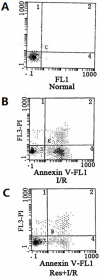Resveratrol attenuates ischemia/reperfusion injury in neonatal cardiomyocytes and its underlying mechanism
- PMID: 23284668
- PMCID: PMC3527482
- DOI: 10.1371/journal.pone.0051223
Resveratrol attenuates ischemia/reperfusion injury in neonatal cardiomyocytes and its underlying mechanism
Abstract
This study was designed to investigate whether Resveratrol (Res) could be a prophylactic factor in the prevention of I/R injury and to shed light on its underlying mechanism. Primary culture of neonatal rat cardiomyocytes were randomly distributed into three groups: the normal group (cultured cardiomyocytes were in normal conditions), the I/R group (cultured cardiomyocytes were subjected to 2 h simulated ischemia followed by 4 h reperfusion), and the Res+I/R group (100 µmol/L Res was administered before cardiomyocytes were subjected to 2 h simulated ischemia followed by 4 h reperfusion). To test the extent of cardiomyocyte injury, several indices were detected including cell viability, LDH activity, Na(+)-K(+)-ATPase and Ca(2+)-ATPase activity. To test apoptotic cell death, caspase-3 activity and the expression of Bcl-2/Bax were detected. To explore the underlying mechanism, several inhibitors, intracellular calcium, SOD activity and MDA content were used to identify some key molecules involved. Res increased cell viability, Na(+)-K(+)-ATPase and Ca(2+)-ATPase activity, Bcl-2 expression, and SOD level. While LDH activity, capase-3 activity, Bax expression, intracellular calcium and MDA content were decreased by Res. And the effect of Res was blocked completely by either L-NAME (an eNOS inhibitor) or MB (a cGMP inhibitor), and partly by either DS (a PKC inhibitor) or Glybenclamide (a K(ATP) inhibitor). Our results suggest that Res attenuates I/R injury in cardiomyocytes by preventing cell apoptosis, decreasing LDH release and increasing ATPase activity. NO, cGMP, PKC and K(ATP) may play an important role in the protective role of Res. Moreover, Res enhances the capacity of anti-oxygen free radical and alleviates intracellular calcium overload in cardiomyocytes.
Conflict of interest statement
Figures







References
-
- Yellon DM, Hausenloy DJ (2007) Myocardial reperfusion injury. N Engl J Med 357: 1121–1135. - PubMed
-
- Chen Z, Chua CC, Ho YS, Hamdy RC, Chua BH (2001) Overexpression of Bcl-2 attenuates apoptosis and protects against myocardial I/R injury in transgenic mice. Am J Physiol Heart Circ Physiol 280: H2313–2320. - PubMed
-
- Kajstura J, Cheng W, Reiss K, Clark WA, Sonnenblick EH, et al. (1996) Apoptotic and necrotic myocyte cell deaths are independent contributing variables of infarct size in rats. Lab Invest 74: 86–107. - PubMed
-
- Gross A, McDonnell JM, Korsmeyer SJ (1999) BCL-2 family members and the mitochondria in apoptosis. Genes Dev 13: 1899–1911. - PubMed
Publication types
MeSH terms
Substances
LinkOut - more resources
Full Text Sources
Research Materials
Miscellaneous

